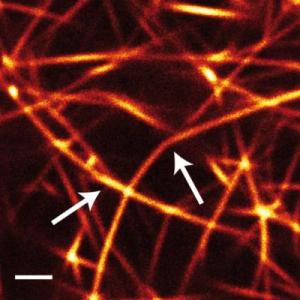Mar 3 2011
Many materials, when observed over a sufficiently long period of time, show changes in their mechanical properties.
The exact course of these developments depends on the underlying microscopic mechanisms. However, the microscopic structure and the complexity of the systems make direct observation extremely difficult.
 Bended actin/fascin bundles indicate stress, incorporated when the network formed. As relaxations over time gradually diminish these tensions, their contribution to the network's elasticity disappears. (length of the bar: 2 µm)
Bended actin/fascin bundles indicate stress, incorporated when the network formed. As relaxations over time gradually diminish these tensions, their contribution to the network's elasticity disappears. (length of the bar: 2 µm)
That is why a team led by Professor Andreas Bausch from the Chair of Cellular Biophysics resorted to a model system that can be precisely controlled using actin filaments, a biopolymer that, among other things, is responsible for muscle contractions in the human body. Together with the crosslinking molecule fascin, actin filaments build an interconnected network whose elasticity decreases with increasing age. Deploying a wide-ranging combination of experimental techniques, the researchers have now managed to cast light on the source of these changes.
As the study published in Nature Materials shows, microscopic relaxation processes are the source of the macroscopic changes in the polymer network properties. During the formation of the network internal tensions build up. Because the linking points in the network are not of permanent nature, but rather open and close at random intervals, these tensions gradually diminish. Over a period of ten hours the elasticity drops to about a fifth of the initial value and then remains stable.
"Crosslinked and bundled actin filaments build networks that are essential for the stability of living cells," says Andreas Bausch, head of the Chair of Cellular Biophysics at the TU Muenchen and member of the Excellence Cluster Nanoinitiative Munich (NIM). "By understanding the microscopic causes for the incredible mutability of the cytoskeleton, we are laying the foundations to advance the development of other polymer materials, as well."